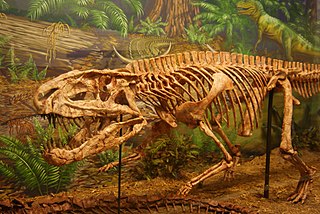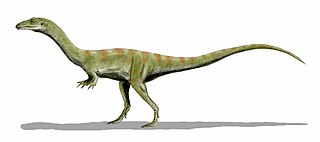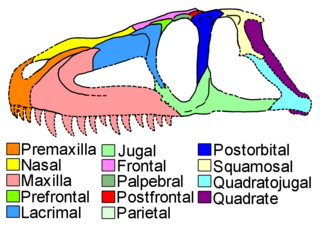
Theropoda, whose members are known as theropods, is a dinosaur clade that is characterized by hollow bones and three-toed limbs. Theropods are generally classed as a group of saurischian dinosaurs. They were ancestrally carnivorous, although a number of theropod groups evolved to become herbivores, omnivores, piscivores, and insectivores. Theropods first appeared during the Carnian age of the late Triassic period 231.4 million years ago (Ma) and included all the large terrestrial carnivores from the Early Jurassic until at least the close of the Cretaceous, about 66 Ma. In the Jurassic, birds evolved from small specialized coelurosaurian theropods, and are today represented by about 10,500 living species.

Eoraptor is a genus of small, lightly built, basal sauropodomorph. One of the earliest-known dinosaurs, it lived approximately 231 to 228 million years ago, during the Late Triassic in Western Gondwana, in the region that is now northwestern Argentina. The type and only species, Eoraptor lunensis, was first described in 1993, and is known from an almost complete and well-preserved skeleton and several fragmentary ones. Eoraptor had multiple tooth shapes, which suggests that it was omnivorous.

Staurikosaurus is a genus of herrerasaurid dinosaur from the Late Triassic of Brazil, found in the Santa Maria Formation.

"Rauisuchia" is a paraphyletic group of mostly large Triassic archosaurs. It belongs to a larger clade called Pseudosuchia, which encompasses all archosaurs more closely related to crocodilians than to birds and other dinosaurs. "Rauisuchia" is currently considered an evolutionary grade, or even a wastebin taxon. It includes most of the large, carnivorous pseudosuchians that lived during the Triassic Period. Since crocodylomorphs likely originated from an ancestor that would have been a "rauisuchian", Rauisuchia in its traditional sense is considered paraphyletic as it excludes crocodylomorphs. To designate it as an informal group in scientific literature, the name in its traditional sense is often enclosed in quotation marks. The monophyletic equivalent of the group Rauisuchia is the clade Paracrocodylomorpha. Paracrocodylomorpha consists of two branches: Poposauroidea, which includes a variety of strange archosaurs, and Loricata, which includes traditional "rauisuchians" and their crocodylomorph descendants.

Herrerasaurus was a genus of saurischian dinosaur from the Late Triassic period. This genus was one of the earliest dinosaurs from the fossil record. Its name means "Herrera's lizard", after the rancher who discovered the first specimen in 1958 in South America. All known fossils of this carnivore have been discovered in the Ischigualasto Formation of Carnian age in northwestern Argentina. The type species, Herrerasaurus ischigualastensis, was described by Osvaldo Reig in 1963 and is the only species assigned to the genus. Ischisaurus and Frenguellisaurus are synonyms.

Procompsognathus is an extinct genus of coelophysid theropod dinosaur that lived approximately 210 million years ago during the later part of the Triassic Period, in what is now Germany. Procompsognathus was a small-sized, lightly built, ground-dwelling, bipedal carnivore, that could grow up to 1 m (3.3 ft) long.

Postosuchus, meaning "Crocodile from Post", is an extinct genus of rauisuchid reptiles comprising two species, P. kirkpatricki and P. alisonae, that lived in what is now North America during the Late Triassic. Postosuchus is a member of the clade Pseudosuchia, the lineage of archosaurs that includes modern crocodilians. Its name refers to Post Quarry, a place in Texas where many fossils of the type species, P. kirkpatricki, were found. It was one of the apex predators of its area during the Triassic, larger than the small dinosaur predators of its time. It was a hunter which probably preyed on large bulky herbivores like dicynodonts and many other creatures smaller than itself.

Shuvosaurus is a genus of beaked reptile from the Late Triassic of western Texas. Despite looking superficially similar to a theropod dinosaur, it is actually more closely related to crocodilians.

Poposauridae is a family of large carnivorous archosaurs which lived alongside dinosaurs during the Late Triassic. They were around 2.5 to 5 metres long. Poposaurids are known from fossil remains from North and South America. While originally believed to be theropod dinosaurs, cladistic analysis has shown them to be more closely related to crocodiles.

Gracilisuchus is an extinct genus of tiny pseudosuchian from the Late Triassic of Argentina. It contains a single species, G. stipanicicorum, which is placed in the clade Suchia, close to the ancestry of crocodylomorphs. Both the genus and the species were first described by Alfred Romer in 1972.

Parasuchus is an extinct genus of phytosaur known from the Late Triassic of Andhra Pradesh and Madhya Pradesh, India. It contains a single species, Parasuchus hislopi.

Saurosuchus is an extinct genus of large loricatan pseudosuchian archosaur that lived in South America during the Late Triassic period. It was a heavy, ground-dwelling, quadrupedal carnivore, likely being the apex predator in the Ischigualasto Formation.

Doswellia is an extinct genus of archosauriform from the Late Triassic of North America. It is the most notable member of the family Doswelliidae, related to the proterochampsids. Doswellia was a low and heavily built carnivore which lived during the Carnian stage of the Late Triassic. It possesses many unusual features including a wide, flattened head with narrow jaws and a box-like rib cage surrounded by many rows of bony plates. The type species Doswellia kaltenbachi was named in 1980 from fossils found within the Vinita member of the Doswell Formation in Virginia. The formation, which is found in the Taylorsville Basin, is part of the larger Newark Supergroup. Doswellia is named after Doswell, the town from which much of the taxon's remains have been found. A second species, D. sixmilensis, was described in 2012 from the Bluewater Creek Formation of the Chinle Group in New Mexico; however, this species was subsequently transferred to a separate doswelliid genus, Rugarhynchos. Bonafide Doswellia kaltenbachi fossils are also known from the Chinle Formation of Arizona.

The Ischigualasto Formation is a Late Triassic fossiliferous formation and Lagerstätte in the Ischigualasto-Villa Unión Basin of the southwestern La Rioja Province and northeastern San Juan Province in northwestern Argentina. The formation dates to the Carnian age and ranges between 231.7 and 225 Ma, based on ash bed dating.

Luperosuchus is an extinct genus of loricatan pseudosuchian reptile which contains only a single species, Luperosuchus fractus. It is known from the Chañares Formation of Argentina, within strata belonging to the latest Ladinian stage of the late Middle Triassic, or the earliest Carnian of the Late Triassic. Luperosuchus was one of the largest carnivores of the Chañares Formation, although its remains are fragmentary and primarily represented by a skull with similarities to Prestosuchus and Saurosuchus.

Chanaresuchus is an extinct genus of proterochampsian archosauriform. It was of modest size for a proterochampsian, being on average just over a meter in length. Fossils are known from the Middle and Late Triassic of La Rioja Province, Argentina and Rio Grande do Sul, Brazil. The type species and only currently known species is Chanaresuchus bonapartei was named from the Ladinian-age Chañares Formation in 1971. A second species C. ischigualastensis named in 2012 from the late Carnian-age Ischigualasto Formation, was briefly assigned to Chanaresuchus before being moved to its own genus Pseudochampsa in 2014. C. bonapartei has recently been found in the Carnian Santa Maria Formation in Brazil. Chanaresuchus appears to be one of the most common archosauriforms from the Chanares Formation due to the abundance of specimens referred to the genus. Much of the material has been found by the La Plata-Harvard expedition of 1964-65. Chanaresuchus was originally classified in the family Proterochampsidae, although it has been placed in the family Rhadinosuchidae in more recent studies.
The Chañares Formation is a Carnian-age geologic formation of the Ischigualasto-Villa Unión Basin, located in La Rioja Province, Argentina. It is characterized by drab-colored fine-grained volcaniclastic claystones, siltstones, and sandstones which were deposited in a fluvial to lacustrine environment. The formation is most prominently exposed within Talampaya National Park, a UNESCO World Heritage Site within La Rioja Province.
The Tiki Formation is a Late Triassic geologic formation in Madhya Pradesh, northern India. Dinosaur remains are among the fossils that have been recovered from the formation, although none have yet been referred to a specific genus. Phytosaur remains attributable to the genus Volcanosuchus have also been found in the Tiki Formation.

Sanjuansaurus is a genus of herrerasaurid dinosaur from the Late Triassic (Carnian) Cancha de Bochas and La Peña Members of the Ischigualasto Formation of the Ischigualasto-Villa Unión Basin in northwestern Argentina.

Smok is an extinct genus of large carnivorous archosaur. It lived during the latest Triassic period. Its remains have been found in Lisowice, southern Poland. The type species is Smok wawelski and was named in 2012. It is larger than any other known predatory archosaur from the Late Triassic or Early Jurassic of central Europe. The relation of Smok to other archosaurs has not yet been thoroughly studied; it may be a rauisuchid, prestosuchid, an ornithosuchid pseudosuchian or a theropod dinosaur.


















